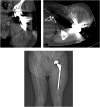Imaging update in arthroplasty
- PMID: 34777990
- PMCID: PMC8577440
- DOI: 10.1016/j.jcot.2021.101649
Imaging update in arthroplasty
Abstract
Imaging of metal implants has historically been difficult, regardless of the applied modality. The number of primary arthroplasties is increasing over the years. With it, we expect the number of symptomatic complications to increase as well. Acquiring accurate imaging for diagnosis and treatment planning for these cases is of paramount importance. Significant advancements have been made to reduce artifacts, leading to better imaging representation of arthroplasty. This review article would give a background on the current ways of imaging arthroplasty and metal implants, covering recent advances in imaging techniques.
Keywords: Arthroplasty; CT scan; MRI; Metal artifact reduction techniques; Orthopedic implants; Radiographs.
© 2021 Delhi Orthopedic Association. All rights reserved.
Figures


















References
Publication types
LinkOut - more resources
Full Text Sources
